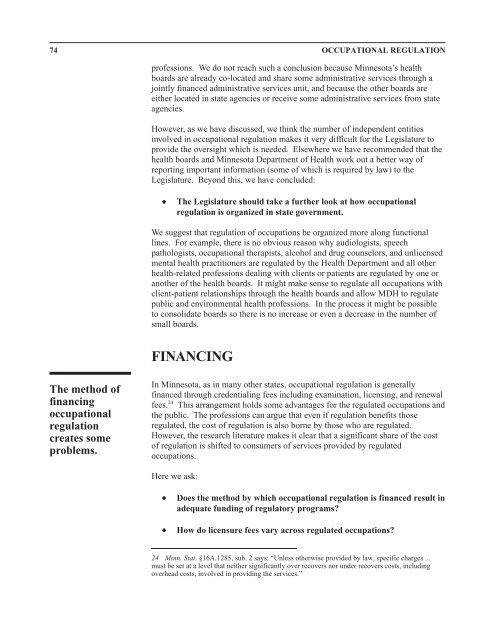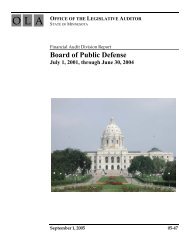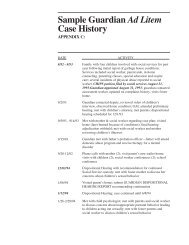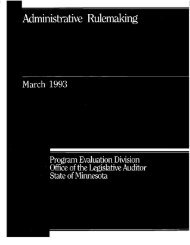Occupational Regulation - Office of the Legislative Auditor
Occupational Regulation - Office of the Legislative Auditor
Occupational Regulation - Office of the Legislative Auditor
Create successful ePaper yourself
Turn your PDF publications into a flip-book with our unique Google optimized e-Paper software.
74 OCCUPATIONAL REGULATION<br />
pr<strong>of</strong>essions. We do not reach such a conclusion because Minnesota’s health<br />
boards are already co-located and share some administrative services through a<br />
jointly financed administrative services unit, and because <strong>the</strong> o<strong>the</strong>r boards are<br />
ei<strong>the</strong>r located in state agencies or receive some administrative services from state<br />
agencies.<br />
However, as we have discussed, we think <strong>the</strong> number <strong>of</strong> independent entities<br />
involved in occupational regulation makes it very difficult for <strong>the</strong> Legislature to<br />
provide <strong>the</strong> oversight which is needed. Elsewhere we have recommended that <strong>the</strong><br />
health boards and Minnesota Department <strong>of</strong> Health work out a better way <strong>of</strong><br />
reporting important information (some <strong>of</strong> which is required by law) to <strong>the</strong><br />
Legislature. Beyond this, we have concluded:<br />
· The Legislature should take a fur<strong>the</strong>r look at how occupational<br />
regulation is organized in state government.<br />
We suggest that regulation <strong>of</strong> occupations be organized more along functional<br />
lines. For example, <strong>the</strong>re is no obvious reason why audiologists, speech<br />
pathologists, occupational <strong>the</strong>rapists, alcohol and drug counselors, and unlicensed<br />
mental health practitioners are regulated by <strong>the</strong> Health Department and all o<strong>the</strong>r<br />
health-related pr<strong>of</strong>essions dealing with clients or patients are regulated by one or<br />
ano<strong>the</strong>r <strong>of</strong> <strong>the</strong> health boards. It might make sense to regulate all occupations with<br />
client-patient relationships through <strong>the</strong> health boards and allow MDH to regulate<br />
public and environmental health pr<strong>of</strong>essions. In <strong>the</strong> process it might be possible<br />
to consolidate boards so <strong>the</strong>re is no increase or even a decrease in <strong>the</strong> number <strong>of</strong><br />
small boards.<br />
FINANCING<br />
The method <strong>of</strong><br />
financing<br />
occupational<br />
regulation<br />
creates some<br />
problems.<br />
In Minnesota, as in many o<strong>the</strong>r states, occupational regulation is generally<br />
financed through credentialing fees including examination, licensing, and renewal<br />
fees. 24 This arrangement holds some advantages for <strong>the</strong> regulated occupations and<br />
<strong>the</strong> public. The pr<strong>of</strong>essions can argue that even if regulation benefits those<br />
regulated, <strong>the</strong> cost <strong>of</strong> regulation is also borne by those who are regulated.<br />
However, <strong>the</strong> research literature makes it clear that a significant share <strong>of</strong> <strong>the</strong> cost<br />
<strong>of</strong> regulation is shifted to consumers <strong>of</strong> services provided by regulated<br />
occupations.<br />
Here we ask:<br />
· Does <strong>the</strong> method by which occupational regulation is financed result in<br />
adequate funding <strong>of</strong> regulatory programs<br />
· How do licensure fees vary across regulated occupations<br />
24 Minn. Stat. §16A.1285, sub. 2 says: “Unless o<strong>the</strong>rwise provided by law, specific charges ...<br />
must be set at a level that nei<strong>the</strong>r significantly over recovers nor under recovers costs, including<br />
overhead costs, involved in providing <strong>the</strong> services.”








